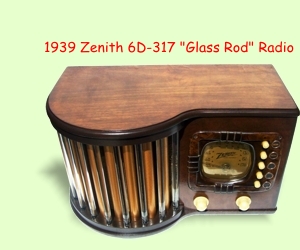|
In a Nutshell
Be careful when comparing: from some distance this radio clock looks like the "fawn" painted bakelite version, but this is the Rare tri-colored UREA version, only made in Canada

Note added Feb. 24, 2016: The radio clock is now on eBay. I got a question about a possible problem concerning the "25 cycles" specified on the chassis and back plane (pict.s 16, 24). Since the clock runs exactly on time, the rotor has to be a 6o cycle rotor. This was verified by taking the clock apart, so the rotor could be identified, as expected and shown in pict.29, as a 3.6 rpm 60 cycles rotor. I suppose, the factory wanted to use their too many 25 cycles chassis'. The 25 cycles power system was the result of the 1895 Niagara Falls project and was used in Ontario and Quebec, northern USA and for railways until the early 1950's. Since the chassis of this radio is transformerless, and the filter capacitors have been replaced with higher values anyway, the influence on the performance of the radio powered with 60 Hz should be negligible.
Introduction:
From Pappy's Telechron website (ref.1 below): A Clock! --- A Radio! --- A Musical Alarm!
♥ The perfect gift for Christmas, birthday and weddings
♥ An entirely new method of wakening
♥ 5-tube superheterodyne radio -- Alnico Speaker
It was Henry Ellis Warren, who in 1908 started to develop what is today known as a Telechron clock (see ref.2 below). The  trademark was registered in 1923. General Electric acquired 50% of Telechron sometime in the 1930's, but took over the prospering company completely shortly after the war. Starting in 1932, Telechron and GE clocks began giving initial model numbers to their clocks to match their function.
The 8 Series was for novelty clocks, timers and radios,
odd-numbered models were Telechrons, even-numbered were GE. The 8H59 (also for sale ref.5) and 8H67 Musalarm were the first dedicated clock radios ever and sold like hotcakes - "clock radio" being understood as a device combining an alarm clock to a radio with the purpose of waking up, not just a radio and a clock sharing the same cabinet, or a radio switched on by a clock to warm up in time. I call the clock radio on sale a "radio alarm clock", because GE built a number of alarm clock radios (1948 6 models of 60 series, and between 1951 and 55 about 20 models of 500 series), which however came in cheap plastic cabinets with much less styling. Note the almost hidden on/off-volume switch of the Telechron, and note the independence claiming naming of Telechron as a section of Canadian GE on the clocks back plane (pict.9). GE ran Telechron into
the ground over a period of several decades, and then sold what was left to Timex. trademark was registered in 1923. General Electric acquired 50% of Telechron sometime in the 1930's, but took over the prospering company completely shortly after the war. Starting in 1932, Telechron and GE clocks began giving initial model numbers to their clocks to match their function.
The 8 Series was for novelty clocks, timers and radios,
odd-numbered models were Telechrons, even-numbered were GE. The 8H59 (also for sale ref.5) and 8H67 Musalarm were the first dedicated clock radios ever and sold like hotcakes - "clock radio" being understood as a device combining an alarm clock to a radio with the purpose of waking up, not just a radio and a clock sharing the same cabinet, or a radio switched on by a clock to warm up in time. I call the clock radio on sale a "radio alarm clock", because GE built a number of alarm clock radios (1948 6 models of 60 series, and between 1951 and 55 about 20 models of 500 series), which however came in cheap plastic cabinets with much less styling. Note the almost hidden on/off-volume switch of the Telechron, and note the independence claiming naming of Telechron as a section of Canadian GE on the clocks back plane (pict.9). GE ran Telechron into
the ground over a period of several decades, and then sold what was left to Timex.
Model 8H67 came in cabinets made from different materials (pict.21). Mine comes in a UREA cabinet, that is very rare, apparently only made in Canada, and is not documented in ref.1. I had the same model 8H67 restored before (ref.3) and uploaded the pictures to the Swiss radio museum (ref.4) under Canadian General Electric. UREA is a prewar plastic, that is extremely hard like catalin. Multicolored UREA is even rarer and the color combination of this model is possibly unique.
Additional information:
ref.1: http://www.telechron.net/postwar/8h67.htm
ref.2: http://clockhistory.com/telechron/
ref.3: http://www.greenhillsgf.com/Project_Telechron_8H67.htm
ref.4: http://www.radiomuseum.org/r/canadian_g_musalarmtelechro_8h678_h.html#c
ref.5: http://www.greenhillsgf.com/IndexOwn_Telechron_8H59.htm
About my Radio Alarm Clock:
The clock is in mint condition with no cracks, chips or scratches whatsoever to the highly glossy UREA cabinet. There are even no hairlines at all, that often plague UREA cabinets, and that are caused by the long-term setting of stress in low temperature molded UREA. The chassis is clean, the speaker cone has no tears, the original back plane (generally replaced) is in good condition. The radio plays perfectly, with no extra antenna needed. Reception and selection are very good. The clock works fine and accurately, the alarm buzz too. Taking pictures of the tri-color marbeled UREA is an adventure, since the result is extremely depending on the kind of illumination (see pictures). The UREA version of this radio clock is getting really rare: it was valued in Mark Stein's "Machine Age to Jet Age II" 1997 at 250$, in "Tabletop Radios" 2003 at 300$, and in "Plastic Radios" 2006 at 350$. I sold my first one (ref.3) in 2010 for $465. Please
e-mail me (Kris) for any questions, ich spreche Deutsch, je parle Français.
For techies only: Often Telechron clockworks stop working because of missing lubrication. Ref.2 above shows pictures of rotors, i.a. of an "H" rotor, and it can be seen, that there is only one hole, for the output pinion. Many people attempt to lubricate the gear inside by trying to open the case or by drilling holes in it. I forgot where I read this recipee, which is working perfectly in all cases I applied it: remove the rotor, put it into an oven preheated to 125°F for 15 minutes, take it out, position it with the pinion up, and drop oil, drop by drop, on that pinion. You'll see the oil disappearing immediately, sucked inside the rotor by the only hole available to equalize the underpressure, generated by the cooling-down rotor case. Fortunately I did not have to do this to the clock of this radio clock, because it works fine and accurately like a charm.
|



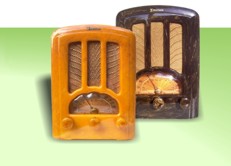







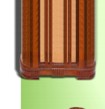
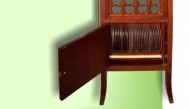



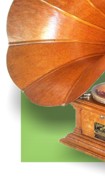
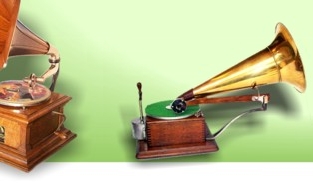
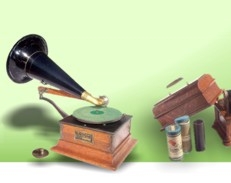
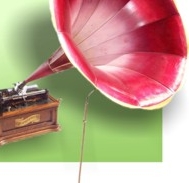

 trademark was registered in 1923. General Electric acquired 50% of Telechron sometime in the 1930's, but took over the prospering company completely shortly after the war. Starting in 1932, Telechron and GE clocks began giving initial model numbers to their clocks to match their function.
The 8 Series was for novelty clocks, timers and radios,
odd-numbered models were Telechrons, even-numbered were GE. The 8H59 (also for sale ref.5) and 8H67 Musalarm were the first dedicated clock radios ever and sold like hotcakes - "clock radio" being understood as a device combining an alarm clock to a radio with the purpose of waking up, not just a radio and a clock sharing the same cabinet, or a radio switched on by a clock to warm up in time. I call the clock radio on sale a "radio alarm clock", because GE built a number of alarm clock radios (1948 6 models of 60 series, and between 1951 and 55 about 20 models of 500 series), which however came in cheap plastic cabinets with much less styling. Note the almost hidden on/off-volume switch of the Telechron, and note the independence claiming naming of Telechron as a section of Canadian GE on the clocks back plane (pict.9). GE ran Telechron into
the ground over a period of several decades, and then sold what was left to Timex.
trademark was registered in 1923. General Electric acquired 50% of Telechron sometime in the 1930's, but took over the prospering company completely shortly after the war. Starting in 1932, Telechron and GE clocks began giving initial model numbers to their clocks to match their function.
The 8 Series was for novelty clocks, timers and radios,
odd-numbered models were Telechrons, even-numbered were GE. The 8H59 (also for sale ref.5) and 8H67 Musalarm were the first dedicated clock radios ever and sold like hotcakes - "clock radio" being understood as a device combining an alarm clock to a radio with the purpose of waking up, not just a radio and a clock sharing the same cabinet, or a radio switched on by a clock to warm up in time. I call the clock radio on sale a "radio alarm clock", because GE built a number of alarm clock radios (1948 6 models of 60 series, and between 1951 and 55 about 20 models of 500 series), which however came in cheap plastic cabinets with much less styling. Note the almost hidden on/off-volume switch of the Telechron, and note the independence claiming naming of Telechron as a section of Canadian GE on the clocks back plane (pict.9). GE ran Telechron into
the ground over a period of several decades, and then sold what was left to Timex.